Ficus rubbery: care, pruning and transplanting at home
For the decoration of the premises of the house, not only flowering crops are chosen, but large ones in the form of shrubs or trees. And if the plant has beautiful large leaves, then it will become the best decoration for the office. Such evergreen crops are chosen ficuses, which, in addition to an interesting appearance, attract with their unpretentiousness in care.
Ficuses are common among indoor crops due to the variety of species. Representatives of the Mulberry family still grow in the subtropical forests of India and Indonesia. There is a special relationship to rubber-bearing ficus. The plant secretes sap, which is used in the production of rubber. And the tree itself is considered sacred, since its presence in the house allows you to cleanse the energy of the premises, helps people get rid of fear and anxiety.
Content:
- Houseplant characteristic
- Choosing a soil and a pot for a tree
- Rules for watering and feeding ficus
- Illumination, humidity and temperature standards
- Pruning to form the crown of a tree
- Transplant terms and rules
- About diseases and pests of ficus
- The consequences of improper care
Houseplant characteristic
An evergreen tree in the subtropics reaches a height of thirty meters, and is considered sacred. Ficus is also cultivated in the countries of the Mediterranean region, where it can grow in the open air. The tree takes up a lot of space in the room, branching over time. Aerial roots formed on the tree trunk reach the ground and give new shoots. Thus, rubbery ficus, or elastic, forms the shape of a banyan tree. No wonder it is also called the snake tree. There are types of ficus with one trunk and several.
Beautiful leathery ficus leaves are oval, 20 centimeters in diameter, they are located alternately on the trunks.
The young leaf blade is colored reddish with a pronounced brown tint. Dutch breeders have developed varieties of rubber ficus with variegated leaves. But they require more careful maintenance. The flowers of the tree are not so beautiful, and they rarely appear on a houseplant, respectively, you can not wait for the fruits.
On the leaves of the plant, you can see droplets of a viscous liquid that contains rubber. Hence the name of rubber ficus. The juice is irritating when it comes into contact with the skin. In addition to latex, it contains alkaloids and enzymes. Large specimens are found in offices ficus up to a meter high with aerial roots. But there are also low bushes up to half a meter, which play a big role in landscaping the premises of the house.
Choosing a soil and a pot for a tree
Ficus can develop fully only in loose and nutritious soil. The main thing is that the soil is permeable. If the water stagnates in the pot, the ficus will die.
Soil acidity for a tree should fluctuate in the region of 6.5-7.0 units. Slightly acidic or neutral soil is suitable.
A young plant needs a loose substrate saturated with air. From the components of the soil mixture, it is better to choose sod soil, peat, sand and leaf humus. All parts are taken in equal amounts and mixed. For looseness, add some gravel or pieces of charcoal to the pot.
Previously, ficuses were planted in tubs, now you can buy beautiful containers, spacious and convenient for the development of indoor culture.
For a young ficus, the substrate is prepared from sod land and leaf humus, adding half less sand. It is necessary that the soil is not too dense. During planting of an adult tree, it is carefully tamped. You can also purchase ready-made soil in the store by choosing a mixture of the Ficus type.
The capacity for the plant is selected depending on the age. A deep pot with a diameter of ten centimeters is suitable for a young tree. After a year, the container is changed, which will be 5-7 centimeters larger in diameter.
Rules for watering and feeding ficus
For a rubber plant, it is important to follow the rules of care:
- Water the tree after the top layer of soil has dried. You cannot pour the plant, as well as dry it.
- The watering liquid should be warm, settled. Do not take chlorinated tap water. It is better to let it settle, warm up, and then water it.
- The tree loves spraying. They arrange a shower regularly, covering the soil in the pot with plastic. This will prevent the water jet from washing away the soil.
- You can replace spraying with wiping the leaves with a damp sponge or cloth.
For feeding ficus, choose and organic, and mineral fertilizers... Fertilizers are applied in liquid form or in granules after the tree has been watered. The feeding procedure is carried out 1-2 times a month. Ficus will look healthy if watered and fed properly.
Standards of illumination, humidity and temperature for a plant
Subtropical plants need a lot of light, but not bright, burning, but diffused light. It is more convenient to place the pot near windows facing west or east. Rubber ficus also develops well in places with a slight shadow. But the growth rate in darkening is reduced, and the lower leaves will dry out.
A lack of light and temperature will immediately affect the state of the leaves of a subtropical culture.
For a plant, air humidity does not matter much. But the temperature in the room is considered comfortable at 20-25 degrees. In winter, it can drop to 16 degrees Celsius. You can save a flower from excessively dry air with humidifiers. Water containers placed near the radiators will help to increase the humidity in the room.
Ficus does not tolerate cold air, drafts. If the house is cool, then you need to wrap the pot with insulation or put it on a warm surface. Ficuses with variegated leaves are provided with long daylight hours and temperatures above 20 degrees Celsius.
Pruning to form the crown of a tree
The rules for caring for ficus include pruning. The procedure is carried out in order to form the crown of the tree, to restrain the chaotic growth of shoots. Before starting pruning, determine the optimal size of the tree, its shape.
In late winter - early spring, only the top can be removed. Then the upper bud will awaken and release the shoot. But the ficus will not branch. You can turn it into a bush by pruning five to six internodes at the top of the stem.
Without trimming, the dimensions of the tree will be too voluminous, and the appearance will be sloppy.
They also activate the growth of lateral shoots in this way: bend the top of the stem to the ground. The kidney on top will begin to grow. During pruning, poisonous plant sap appears on the trunk, so it is necessary to carry out the procedure with gloves. At the end of it, the cut points are sprinkled with activated or charcoal.
Transplant terms and rules
There is no special wisdom in transplanting rubber ficus:
- Young trees need a pot change every year.
- Three-year-olds are transplanted every two to three years.
- They start with the selection of a container for ficus, which should be 4-5 centimeters larger than the previous one.
- The mixture of soil is placed in a container by half, then, carefully spreading the roots, they put a tree, supporting it.
- Add the remaining soil and compact the earth tightly around the trunk of the ficus.
For a young plant, the substrate is prepared from one part of peat and sod land and half of the sand. For adult plants - in equal amounts of leaf humus, turf, peat and sand.
The optimal time for a ficus transplant is early spring, while the buds have not yet woken up. If the transplant is carried out carefully, then the plant will begin to develop rapidly, forming new shoots.
About diseases and pests of ficus
Of fungal infections, gray rot affects the plant when the room is humid and hot. Perennial stems and leaves are covered with a grayish bloom. Over time, the foliage dies off, falling off. You can cope with the disease by removing the affected areas. And the container with the plant is moved to a well-ventilated, dry room. The sooty fungus is determined by the black bloom on the leaves. The areas affected by the fungus are removed, and the rest of the plant is washed with soapy water and sprayed fungicidal agents.
When infected powdery mildew spray the tree with a solution of copper sulfate and soda ash. Ten grams of soda and two grams of laundry soap are diluted in a liter of water. After adding two grams of copper sulfate, bring the volume of liquid to two liters.
If the fungi have penetrated the roots of the plant, then it cannot be saved - it is necessary to separate the healthy cutting and plant it in a separate pot.
Of the pests of ficus, spider mites are often found. It is identified by a thin web and grayish-brown spots on the leaves. Aphids they are recognized by the sticky coating on the leaves, their yellowing and deformation. The pest is dangerous because it attracts pathogenic fungi with its secretions. It is better to fight parasites on ficuses insecticidal preparations.
The consequences of improper care
Many pathological conditions of ficus arise as a result of improper care (plant leaves are especially sensitive to changes in growing conditions):
- The edges of the leaves turn yellow as a result of sunburn or high indoor temperatures.
- The leaves will turn yellow if you often rearrange the flowerpot with ficus from one place to another.
- Ficus is famous for its large leathery leaves. But they can become smaller if the plant lacks nutrients.
- Abundant fall of foliage is associated with excess moisture in the soil and air. Rare watering leads to the drying out of the leaf plate. In both cases, it is necessary to correct the situation in time so that the roots of the plant do not rot or dry out. Then the ficus will not save anything.
- The appearance of brown spots on the green parts of the plant is a signal that the tree is hot and there is excess fertilizer in the soil.
- The exposing of the ficus trunk below occurs constantly. But at the same time, new leaves appear again. If this does not happen, then the matter is in the wrong care.
Ficus will develop correctly, look healthy when it is properly looked after.
More information can be found in the video:



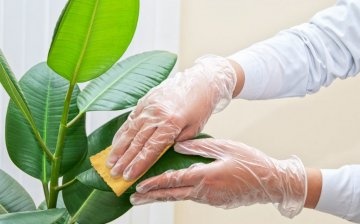
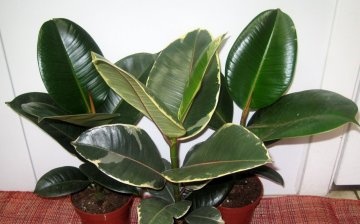

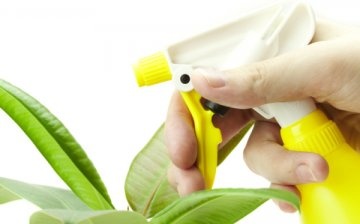
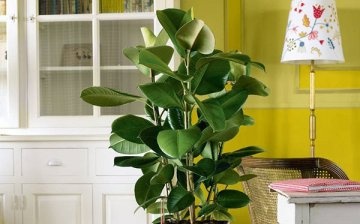
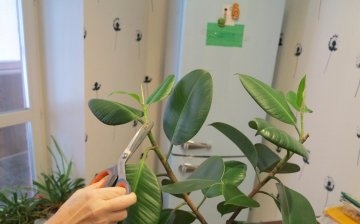

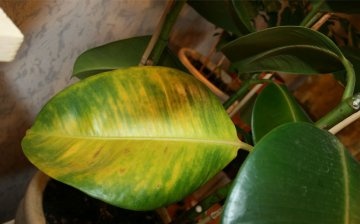
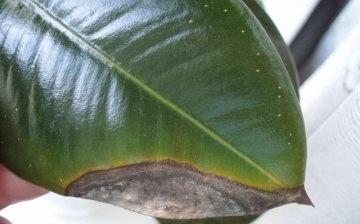









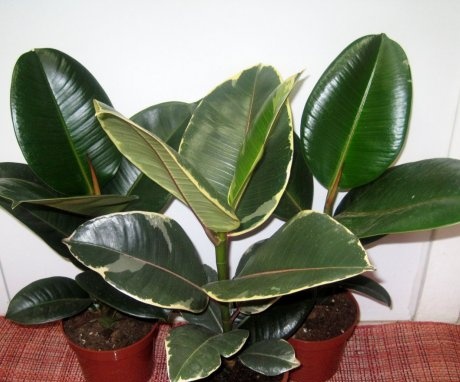
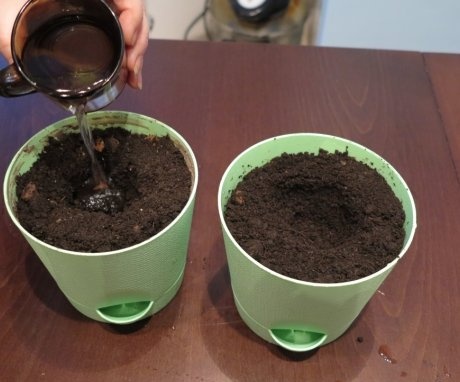
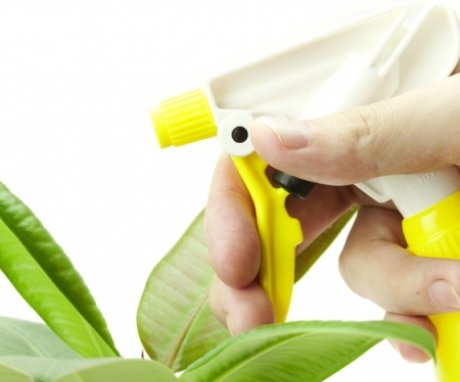
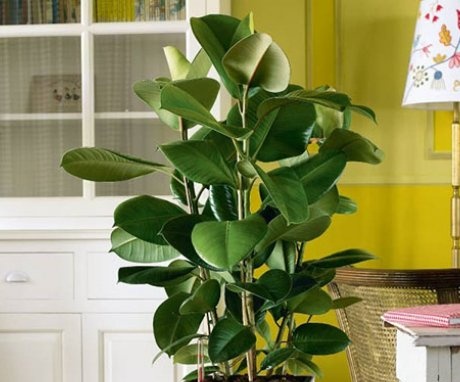
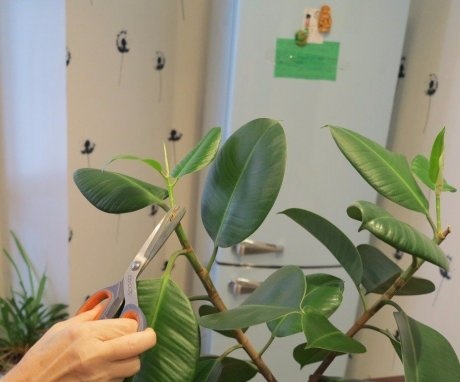
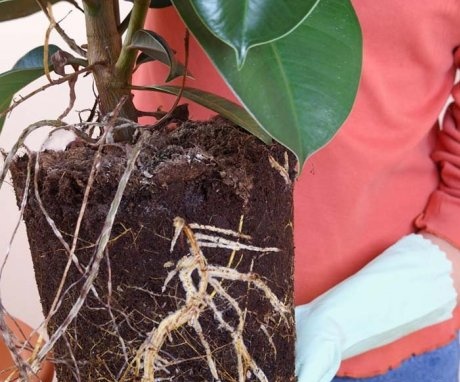
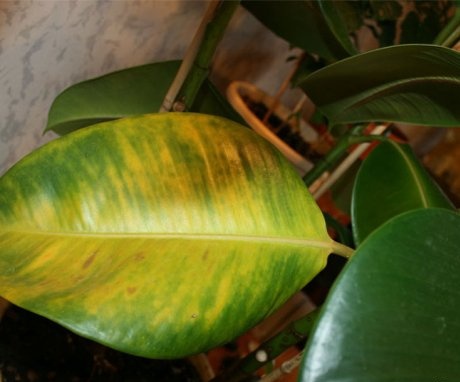

My ficus grows perfectly, I can say that the east window is perfect for him. It is important not to water too abundantly and protect the flower from bright lighting. And also do not put in drafts. In the summer I take it out on the balcony.
Our ficus grows well too. We form! Do you shape it? Or is it growing at random? We also give him top dressing, since we rarely change the earth, and it is already depleted in about two years.
Our ficus grows well too.We form! Do you shape it? Or is it growing at random? We also give him top dressing, since we rarely change the earth, and it is already depleted in about two years.
For our grandmothers, ficus was an obligatory plant in the apartment. Even you watch all the old films - the ficus is always present there. Now, I look, has reappeared in stores. I should probably also take a closer look at him.